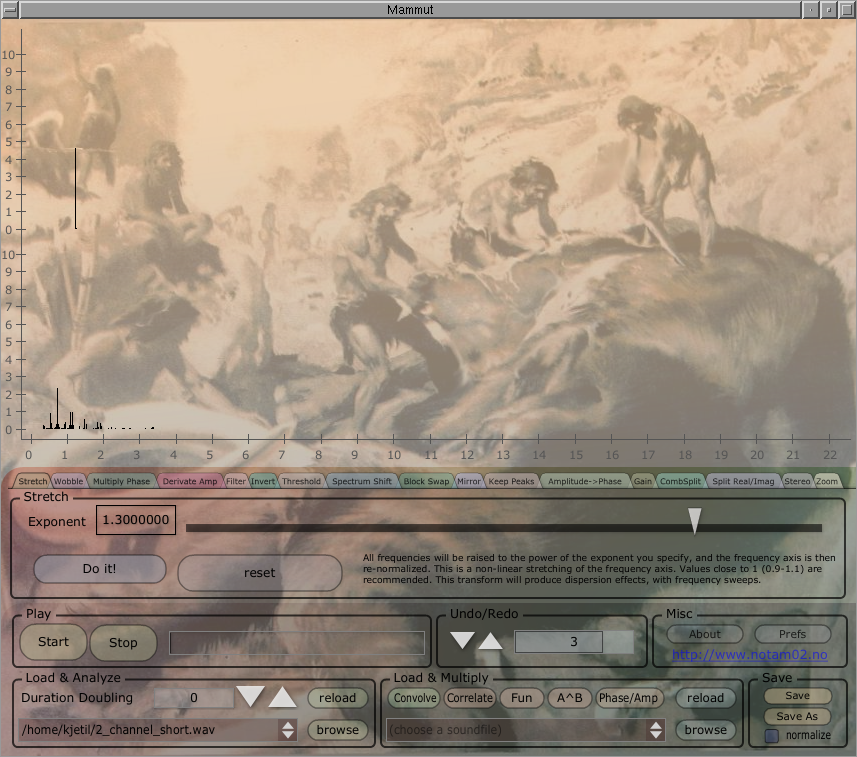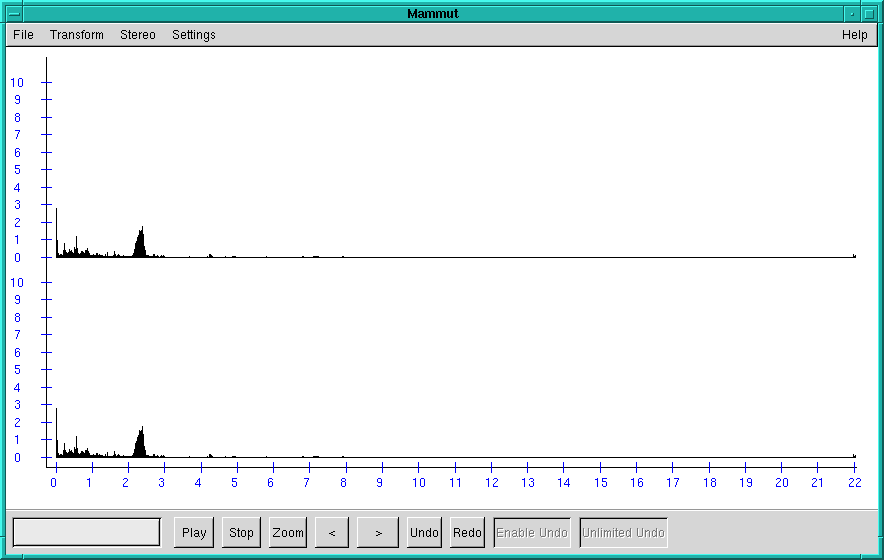... something like Hadron then?manvanmars wrote:Ok, guess you would have to automate the parameters between presets then.... Only not sure if it would be worth the time, that's gonna be really messy...Neon Breath wrote:
Hmmm no I'm afraid a simple preset morph would only volume-cross fade between the two presets, and not truly and harmonically morph into each other.
High quality audio morphing effect plugin, why it doesn't exist yet?
-
- KVRer
- 4 posts since 19 Nov, 2012
- KVRAF
- 3426 posts since 15 Nov, 2006 from Pacific NW
Not to divert the thread into a technical direction - oh wait, I'm actually fine with this.monas wrote: i think i'll start a thread about it over at reaktor board where discussions stay productive and technical (mostly)
fft geeks are welcome to join in.
Anyway: FFT in Reaktor. How does this work? My last heavy lifting in Reaktor was in 2003, and I didn't know that there was FFT support in there.
To my mind, Max/MSP is the "classic" visual programming environment for working with FFTs, with Pure Data being the "ugly, but free and runs everywhere" choice. Someone with fairly basic Max/MSP skills could probably code up a simple magnitude/interpolator fairly quickly. Of course, Max/MSP no longer runs as a plugin, so Reaktor would be a better way of getting things into your DAW.
Amplitude/frequency can ABSOLUTELY be resynthesized by iFFT. You just need to convert the values from the polar domain back to the rectangular domain. Most FFT processing uses iFFT for efficiency.monas wrote: what you need is amplitude/frequency, which can't be resynthesised by iFFT, only in an additive way.
That being said, using a bank of sinusoidal oscillators allows for more robust manipulations of the amplitude/frequency data. It is easy to shift the output frequencies, just by multiplying the oscillator frequency. The results might be weird, as the time varying amplitude data carries a lot of the pitch information as well, but the point is that a sine oscillator bank can be really fun to control with information from phase vocoding analysis.
Sean Costello
-
- KVRist
- 163 posts since 26 Sep, 2012 from bavaria
There were some FFT building blocks introduced into Reaktor Core i think in 2006/7 plus some user mods have been made to them to offer bigger frame sizes. Unfortunately there isn't many UL uploads that make use of them. They are a bit clumsy to use and only offer double overlaps (afaikt), but they work fine. Also core doesn't deal with samples "blockwise" like PD/Max does, which sometimes makes FFT easier to grasp in PD/Max. Apart from that Reaktor offers all that PD/Max offers, FFT/iFFT, poltovec/vectopol, and so on, and it puts it all right into your DAW.valhallasound wrote: Anyway: FFT in Reaktor. How does this work? My last heavy lifting in Reaktor was in 2003, and I didn't know that there was FFT support in there.
Here's a spectral delay i made using Reaktor FFT:
http://co.native-instruments.com/index. ... chid=12159
The problem is just that there's a lot of conversion involved, because if you want to compute the frequencies, you need to have the phase differences first, then calculate the deviation from the bin frequency from that and add the corresponding bin frequency. On the way to there you lose the absolute phases. If you want to make your way back after processing the frequencies now, you need to convert to phase differences again and calculate the running phase, then IFFT. But you can't do anything you like to process the frequency data for some reason i don't fully understand. As you said, an additive resynthesis is much more flexible.valhallasound wrote: Amplitude/frequency can ABSOLUTELY be resynthesized by iFFT. You just need to convert the values from the polar domain back to the rectangular domain. Most FFT processing uses iFFT for efficiency.
For the morphing i found a way around this problem. What i am using instead of the frequencies is the phase deviations which i interpolate. Then i feed it right back into the running phase calculation and into the IFFT. I finished it up today, and the morpher works perfectly fine. I'll share it soon.
But what i was actually working on is to get the additive synthesis happening in Reaktor, so everyone can have some fun with FFT in Reaktor and stretch and shift things without any maths involved.
- KVRAF
- 25419 posts since 3 Feb, 2005 from in the wilds
As soon as you create a morphing tool that gives a consistent and good result, you will disprove that 'fact'. Until then, it stands as the factual reality. There currently is no such tool.monas wrote:hmmm...
there's plenty of articles that were posted on the issue of morphing here.
i don't believe that the "fact" that you can't get a consistent and good result from a morphing tool is the reason why developers haven't invested in it. i think it's simply because it's a kind of processing that's too exotic. why run a risk when there's easier money elsewhere?
-
ChamomileShark ChamomileShark https://www.kvraudio.com/forum/memberlist.php?mode=viewprofile&u=25116
- KVRAF
- 2834 posts since 12 May, 2004 from Oxford, UK
interesting discussion. I'm wondering if when/if this eazymorph plugin is produced at low, low prices it will still be one of those things that is difficult to create something that is musically useful without a fair amount of work. Maybe it's less about the technology.
In the meantime I'll be trying Neon's suggestions for morphing in Alchemy published in another subforum (thanks for that).
btw, anyone else tried Hadron as a couple of people suggested?
finally thanks Monas for the Reaktor spectral delay, I look forward to trying that later.
In the meantime I'll be trying Neon's suggestions for morphing in Alchemy published in another subforum (thanks for that).
btw, anyone else tried Hadron as a couple of people suggested?
finally thanks Monas for the Reaktor spectral delay, I look forward to trying that later.
Pastoral, Kosmiche, Ambient Music https://markgriffiths.bandcamp.com/
Experimental Music https://markdaltongriffiths.bandcamp.com/
Experimental Music https://markdaltongriffiths.bandcamp.com/
- KVRAF
- 9577 posts since 16 Dec, 2002
This link might be useful
http://csounds.com/node/1485
Its for python scripts that turn any Csound CSD into a VST, supposedly.
As Csound is probably the Daddy of FFT it could be useful to someone.
http://csounds.com/node/1485
Its for python scripts that turn any Csound CSD into a VST, supposedly.
As Csound is probably the Daddy of FFT it could be useful to someone.
Amazon: why not use an alternative
-
- KVRAF
- 4065 posts since 2 Jul, 2005
i've just been playing around with the morphing in alchemy again and I think it can do a pretty damn decent job of morphing between relatively complex sounds. Basically if the resynthesis sounds natural the morph will also. anybody want to send me two files for a demonstration?
Don't F**K with Mr. Zero.
-
- KVRist
- 154 posts since 24 Aug, 2012
Try mammut. It uses one FFT for all the sound, so it doesn't reduce sound quality (no windows), and it has 5 different ways to morph sounds (Look under "Load & Multiply").
http://archive.notam02.no/arkiv/doc/mammut/

http://archive.notam02.no/arkiv/doc/mammut/

-
- KVRist
- 181 posts since 5 Apr, 2009 from Berkshire, UK
This looks a potentially interesting app but... what the hell were they thinking with that moving background? I cannot imagine a more distracting thing to do except possibly to have it play sound effects also. Oh wait no they do that too.kmatheussen wrote:Try mammut. It uses one FFT for all the sound, so it doesn't reduce sound quality (no windows), and it has 5 different ways to morph sounds (Look under "Load & Multiply").
http://archive.notam02.no/arkiv/doc/mammut/
Update: Okay I found the prefs button. In my defence I think I would have seen it more easily if not for being distracted by the background and sound effects!
Kind regards,
Matt
Last edited by sandbags on Sun Feb 24, 2013 1:16 pm, edited 2 times in total.
-
- KVRist
- 154 posts since 24 Aug, 2012
You could try to press the "Prefs" button...sandbags wrote: I looked briefly for a way to turn that stuff off and didn't find one. Do you know if there is one?
Kind regards,
Matt
-
- KVRist
- 181 posts since 5 Apr, 2009 from Berkshire, UK
-
- KVRist
- 154 posts since 24 Aug, 2012
Good to hear. I was hired to brush up the interface for the program. Before, it looked like this:sandbags wrote:Thanks, found that just as you were writing.

But perhaps I went a little bit far.
-
- KVRist
- 181 posts since 5 Apr, 2009 from Berkshire, UK
Sorry, I may have gone a bit overboard in my criticism. Minus the background and sound effects what you've done looks very much better than your screenshot of the original. As a Mac user I'm frequently caught out by non-standard UI: my expectation is preferences in the menubar. I didn't think to look for a prefs button on the page and found it kind of hard to see.
Some interesting effects here. Kudos for explaining what some of them are doing!
Kind regards,
Matt
Some interesting effects here. Kudos for explaining what some of them are doing!
Kind regards,
Matt
-
- KVRAF
- 3477 posts since 27 Dec, 2002 from North East England
Mammut is great, but can't do audio morphing as far as I'm aware. It has some nice options for creating and combining spectra, but as it FFTs everything into one giant window it's not the best choice for effects which evolve over time AFAIK.
Someone mentioned FScape earlier. Again, great program, but not capable of morphing to my knowledge. The whole general purpose Fourier translation part of it is a bit mysterious and difficult to understand to me. It creates wav files (!) and I'm not really sure what to do with them or how to go about further processing them. Well, not without resorting to speculatively hacking them up with traditional time-based methods then resynthesising that is.
Someone mentioned FScape earlier. Again, great program, but not capable of morphing to my knowledge. The whole general purpose Fourier translation part of it is a bit mysterious and difficult to understand to me. It creates wav files (!) and I'm not really sure what to do with them or how to go about further processing them. Well, not without resorting to speculatively hacking them up with traditional time-based methods then resynthesising that is.



